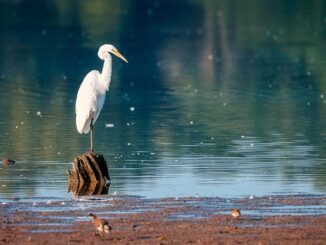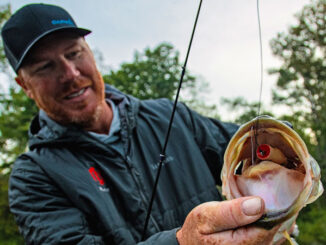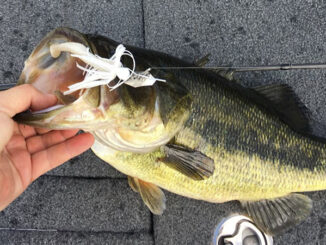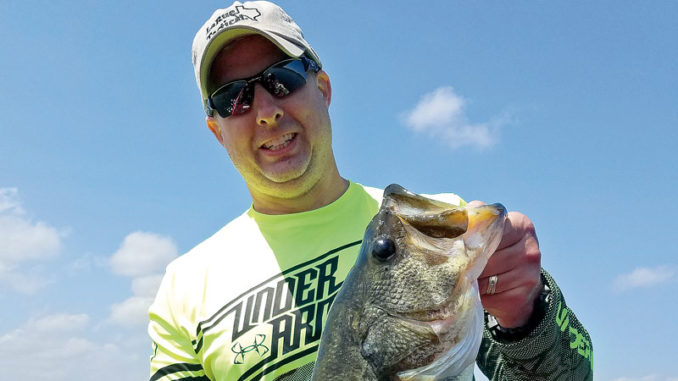
Whether you target Toledo Bend’s bass in the back of creeks in March or on the outside ridges in late March, it’ll be time to feed them a steady diet of soft plastics such as Senkos and Super Flukes, the former either Texas- or wacky-rigged and the latter either Texas- or Carolina-rigged.
And if you intend to intercept them going to or coming back from their spawning sites in those areas, offer a bladed jig, a lipless crankbait or a jerkbait. You can’t go wrong. If I had my druthers — and I do — I’ll be fishing a Senko or Fluke from late February into April.
The biggest and best thing about this time of year is that the odds swing in your favor as far as hooking and boating a double-digit bass. This, my friends, is the time to spend more time on the water if you want to catch a bass weighing 10 pounds or better. It’s the golden opportunity afforded every year at this time. Heck, a 10-pound, 9-ounce hawg made the day for Matthew Kahrs of Barbe High School in Lake Charles on Jan. 26 during the Bassmaster High School Series. Kahrs, who was fishing with his brother, Christopher, said the lunker bit on a watermelon/candy Zoom Baby Brush Hog in 10 feet of water. The brothers finished second overall with 15 pounds, 6 ounces.
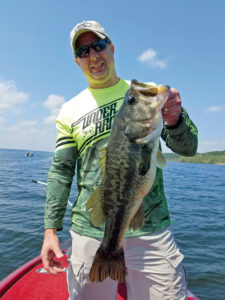
That’s the kind of bass, and bigger, I’m talking about in this border lake shared by Louisiana and Texas. As January gave way to February, the lake was at its highest level in months — 167.37 — and slowly rising, which bodes well for even more bassing success in the spring. With the pool hovering around 165 for what seemed like forever, some winter rains started the rise, and more are on the way, based on weather patterns. It’s been a strange winter — damp and fairly cold, unlike last year when there was a two-week Indian summer and bass stormed the beaches from west to east.
The prolonged low-water period did give green stuff time to grow on exposed ridges and flats. About a week ago, I told an outdoor writer it needed to come up 3½ feet to get on top of most of the new greenery on ridges, flats and shorelines, and that would be 168.5 feet, perhaps a little higher. It’ll be around 168 by mid-February, but it’s a slow process based on the weather patterns. It’s possible it’ll get to 169 or 170.
With the lake rising like this — and when it gets heat on the water — the bass will come up. The water needs to rise to the point it’s in the haygrass and bushes, which is where most of the bass will be found.
Remember the full moon, March 9. That first full-moon cycle of the spawning period will trigger bass, particularly in warmer water. But remember, the fat girls don’t have to have prime water temperatures to spawn. When the biological clock ticks to zero, they go.
Still, many bass will be caught wherever the water’s warmest, and that’s why bass and anglers hit the back end of major creeks like Six Mile, Housen, Negreet and others. Two or three degrees makes all the difference in the world, even if the water’s stained, which has its advantages.
The first week of February, for example, the average water temperature was 56 to 57 degrees inside and 54 degrees outside. As the air warms with each succeeding week, the water temperature rises on the main-lake ridges to the point where it’s the same as the inside. When the whole body of the lake falls into the same water temperatures as the back end, the ridges are the place to be. Late March should be offshore time, and I really won’t have to travel inside that much if at all to catch bass.
It’s no secret I love to fish a wacky-rigged Senko in green pumpkin or watermelon or a similarly colored Fluke on a Carolina rig. Often, that’s all I need from March all the way through April and into May.
When I use a wacky rig, I use the O-ring and insert a 7/8-inch galvanized roofing nail in the nose of the Senko, then clip off the head. The bass seem to like it falling nose-first better.
White perch (crappie) fishing should be great in March. Look for them in around channels and ditches that run into coves and eventually into flats. You can find them with soft plastic tube jigs and/or Blakemore Roadrunners, then focus on that area with minnows.
